Premium Tours India Your online Tour Guide for Incredible India Trip
Recommended Tours
01 The Taj Mahal 02 Pushkar Fair 03 The Golden Temple,Amritsar 04 Camel Safari 05 River Rafting 06 Varanasi Ghat More... |
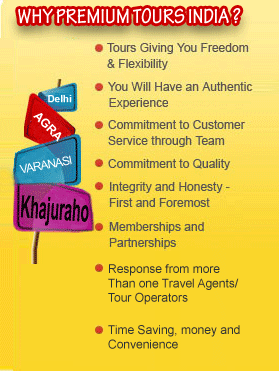
You Are Here >> Premium Tours India >>Special Interest Tours >> Incredible India Tours
Duration: 28 Nights / 29 Days
Destinations Covered : Delhi - Udaipur - Ranakpur - Narlai - Rohet - Jodhpur - Jaipur - Fatehpur Sikri - Agra - Varanasi - Kathmandu - Delhi -Chennai - Mahabalipuram - Kanchipuram - Pondicherry - Tanjore - Trichy - Madurai - Periyar - Alleppey - Houseboat - Kumarakom - Cochin - Departure
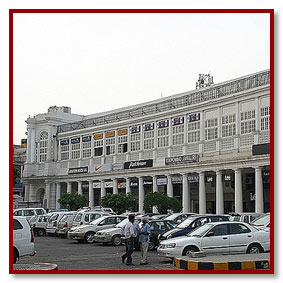
Day 01: Arrival / Delhi
Late night arrival. Meeting and assistance upon arrival as our representatives welcome you and escort you to your car & transfer to already booked hotel as mentioned in itinerary.
Whilst the room keys and check-in is organized, our representative would introduce the tour to you and hand over the documents to you.
Welcome to India, or as we say ‘atithi devo bhava’ (the guest is an incarnation of God). Thank you for giving us the opportunity to serve you!
Overnight stay at hotel ( depend on your choice ).
Day 02: Delhi Cultural Tours
Following a leisurely breakfast, we proceed on a guided tour of old & new Delhi covering most incredible & famous sights of delhi & during day trip enjoy cycle rickshaw ride also.
Overnight at hotel.
Day 03: Delhi / Udaipur
Early morning transfer to airport to connect your flight to Udaipur, a royal capital of a divine dynasty
Welcome to Udaipur, the famed “City of sunrise”. Founded in 1567 by Maharana Udai Singh, from the lineage of the legendary Sisodias of Mewar - the decedents of the sun God. A city where the sun truly never set, where tradition and a strict code of heroism were happily united with a love of fine living. A city that has come to be an oasis of romance in the warrior state of Rajasthan
Meeting and assistance upon arrival check into the hotel. Upon arrival check in to hotel.
After rest and relaxation proceed on a guided tour of "Lake City". Udaipur is a cool oasis in the dry heart of Rajasthan. It is probably the most romantic city in a state where every city has some romantic or exotic tale to tell. The huge city palace towering over the Lake Pichola is the largest palace complex in Rajasthan. Though it is a conglomeration of buildings built by successive rulers, it manages to retain a surprising uniformity of design and affords very fine view of the lake and the city from the upper terraces. The Jagadish temple next to the city palace enshrines a black stone image of Lord Vishnu and his vehicle- a mighty bird called garuda - in a brass image. The temple is a very fine example of Indo-Aryan Art.
Later in the evening we enjoy a boat cruise on the serene and beautiful Lake Pichola. The island palace on the Lake called Jagmandir Palace is quite fascinating. The Palace provided inspirations and ideas to the builder of the Taj Mahal. The banks of the lake provide interesting glimpses of the daily bathing and the laundry that takes place here. Looking across the lake, with the city and its great palace rising up behind the island palace, is a scene of rare beauty.
Overnight at Udaipur hotel.
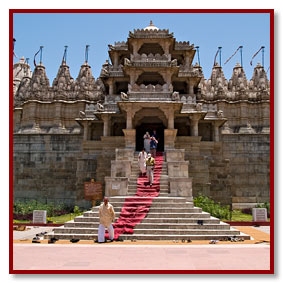
Day 04: Udaipur / Ranakpur / Narlai (160 Kms)
This morning we drive to Narlai en route we will visit Ranakpur.
The Ranakpur Jain Temple was built during the reign of the liberal and gifted monarch Rana Kumbha in the 15th century. The basement is of 48,000 sq. feet area that covers the whole complex. There are four subsidiary shrines, twenty-four pillared halls and eligibly domes supported by over four hundred columns. The total number of columns is 1,444 all of which are intricately carved with no two being alike. The artistically carved nymphs playing the flute in various dance postures at a height of 45 feet are an engrossing sight. In the assembly hall, there are two big bells weighing 108 kg whose sound echoes in the entire complex. The main temple is of Chaumukh or four-faces temple dedicated to Adinath. Following the tour of Ranakpur we continue our drive to Narlai
Upon arrival check into Narlai hotel.
Late afternoon, we would have an escorted stroll through the small town, bustling with activity and bursting with colour- perhaps pausing to see the rich handicrafts or even to design your own silver Tabiz, a ancient lucky charm, both for women and men- worn around the neck, at the silversmith.
Overnight at hotel.
Day 05: Narlai / Rohet (90 Kms)
Wake up to the sounds of this 17-century village, and take in the spiritual energy from descending from the Shiva Temple, deep in a primal cave, on the hill overlooking your room. You may hear whispers of the early morning chanting coming from the many temples and mosques. At breakfast you are encouraged to feed the harmless monkeys, if they come down from the hills, as a token of prayer to Lord Hanuman.
After breakfast we drive to Rohet. Upon arrival, check into heritage hotel.
At Rohet, one is transported in to a world of the past, a world of honour and of chivalry, of glory and of pride; a world of vibrant colours and spectacular magnificence. Past centuries come to life at the historic boundary walls of Rohet- the 16th century fortified deserted home of a Rajput clan. Within the precincts of these time weathered walls is our hotel, the impressive Rohetgarh Fort- a bastion of proud Rajput traditions bathed in the ambience of unmistakable Rajasthani culture where one can, even today experience the famed warm and courteous Rajput hospitality. Frescoes on the tall gateway, brightly painted in the traditional style, using traditional motifs and colour schemes herald your entry to this charmed world the bygone era. The gateway leads to a compound where a profusion of flowers frame the archways in welcome. The portico is a warm and informal place decorated with the artifacts and trophies of many years. Exquisitely carved furniture, delicate hand block prints, original paintings and photographs decorate your rooms, which though redolent with the romance of a bygone era, provide all the modern amenities. Antique hunting riffles, shields & spearheads, daggers and original paintings form the backdrop of the dinning room. The swimming pool here is in beautiful settings and is an oasis in a dessert.
The food at Rohetgarh is special; each recipe is both traditional and typical, handed down the generations and jealously guarded to retain its pristine flavours. You savour only the very best of Rajasthani cuisine’s, food favoured by the Royalty. The 16th century descendants of the Rathore ruling family still live here and host the guests. The members of the Royal family interact with the guests and interesting stories and anecdotes are narrated.
We would also explore Rohet, which is a fascinating small feudal town, which seems to be straight out of the Arabian Nights. There is no proper road here - only one main dust trail. On either side are typical thatched houses and shops of all kinds - colourful bangles, silver jewellery, potters, fruit vendors on carts, dress shops, tailors etc.
Late afternoon we enjoy jeep safaris to visit the heart of Rajasthan villages where traditions centuries old still permeate life styles. One can witness the ‘opium ceremony’ - a ritual by which guests are welcomed. Gaily attired men and women carry on their chores and one can catch a glimpse of their norms and customs. The smoothened mud floors of the village huts remind one of the simple and traditional living here.
As evening descends, the darkness of the night is lit up by the flickering flames of fire around which the rhythmic movements of the folk dancers assumes shape in brilliant colours; truly an electrifying experience.
Overnight at heritage hotel.
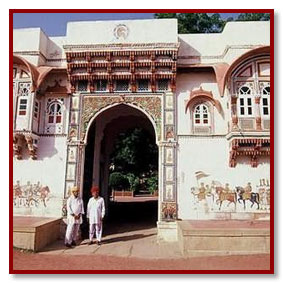
Day 06: Rohet / Jodhpur (40 Kms)
After a leisurely breakfast drive to Jodhpur
Upon arrival, check into the legendary Ajit Bhawan Hotel, Set in the serene desert of Rajasthan, this hotel stands as an oasis of hospitality and warm Rajput charm. Built exclusively for Maharaja Sir Ajit Singh, it is vibrantly alive with the personalized hospitality provided by the late Maharaja’s family who still live there. The doors of this truly traditional yet subtlety contemporary estate is open to you and offers you Old World elegance, with the modern comforts of a classic heritage hotel and the essence of being a guest of the Maharaj’s family.
After rest and relaxation, we proceed on a guided tour of Jodhpur. Our tour includes the massive fort. In olden days this must have been impregnable since its rocky base is scraped straight down making it nearly impossible to ascend. Once inside, royal palaces abound with fascinating history and priceless jewels, on to the armoury and Jaswant Tara - the Royal Crematorium.
Later afternoon, we would ride horse carriages to the Clock Tower Bazaar. This is one of India’s largest and most colourful wholesale markets especially with respect to clothes, fabrics, spices, vegetables etc. It is a fantastic experience to walk through the place observing and photographing this incredible spectacle of vibrant lifestyles and incredible colours.
Overnight at hotel.
Day 07: Jodhpur / Jaipur (325 Kms)
After breakfast we will drive to Jaipur
Upon arrival, check in to Hotel Alsisar Haveli - This is the flagship hotel in a bouquet of heritage hotels. The Haveli lies tucked away in the heart of Pink City, Jaipur. It brings back to life the grandeur of the old days and is a memorable regal Rajasthan experience for the guests. Refurbished in 1982, the Haveli incorporates the finesse of traditional Rajput architecture and a site to behold. The large elevated platform that dominates the central area of the ground floor and once used for get-togethers by the gents of the house is now open to guests who can witness puppet shows and folk dances while enjoying their snacks or drinks. The spacious lobby which opens into the chowk (inner courtyard), was a century ago used by the ladies of the house and is now open to guests. You will treasure this experience of staying in an authentic Rajput home.
After rest & relaxation, we explore the unending shopping options of Jaipur along with our Guide. An essential starting point for Rajasthan craftwork is block making and block printing and we will be exploring the process from start to finish in some of the popular stores here. The opportunity also exists here to tailor make outfits to your design and size.
We also explore one of the chief attractions of Jaipur - its jewelry, which offers a variety that ranges from chunky tribal jewelry to enameled gold to modern diamond jewelry. Kundan (art of stone setting) and enamel jewelry has been a specialty of Rajasthan, particularly that of Jaipur. The stones are embossed into decorative shapes & patterns and embellished with delicate enamel ornamentation in the champeve (raised field) technique. Jaipur is well known for its gold and silver enameling. Colorful bangles made of lac and set with semiprecious stones make an inexpensive buy. The craftsmen take great pains to embed the hundreds of stones into the lac. The skilled gem-cutters of Jaipur carve enchanting little animals and birds from rock, crystal, jade, smoky topaz and amethyst. Intaglio beads & buttons and crystal scent bottles are also available.
Overnight at hotel.
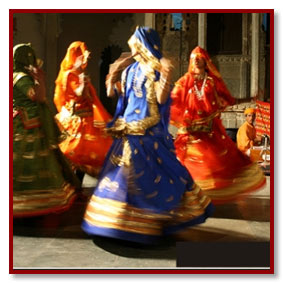
Day 08: Jaipur Cultural Travel
After a leisurely breakfast we visit Amber Fort, the former capital of the royal Jaipurs. Few fail to be moved by the dramatic Rajput grandeur of this hilltop fortress-palace 11 km north of Jaipur. Set on the dry wrinkled Aravali Hills, and surrounded by fortified battlements, the palace straddles two sepia-hued tundra hills overlooking Maota Lake, and its sprawling crenellated walls lattice the surrounding hills.
We will ride up to this hilltop palace on a caparisoned, painted elephant, passing through the ancient main gate where Maharajas of Jaipur have entered for four hundred years. Our guide will elaborate on the history of this architectural masterpiece with its mirror-studded alcoves, dazzling mosaics and water-cooled swings that delight today’s visitors as they did their former royal residents.
Later, we proceed on a tour Of the City Palace & Observatory. The City Palace in the heart of the old city is a blend of Rajasthani and Mughal architecture. The centre of the palace is a seven-storied building called Chandra Palace, with fine vies over the gardens and the city. The palace lies in the heart of the city and occupies the whole central grid. The fortified wall has seven gates and was built for protection from invading armies and animals that lived in jungles, which surrounded the wall that time. Next, we visit the Solar Observatory - an astronomical treasure house, with solar device that give accurate predictions till date.
Overnight at hotel.
Day 09: Jaipur / Fatehpur Sikri / Agra (245 Kms)
After a leisurely breakfast we drive to Agra stopping at deserted Capital City of Fatehpur Sikri. This abandoned capital of the Mughals is a perfectly preserved city at the height of the empire’s splendour. The city divided into religious and secular parts has interesting well-sculpted buildings.
Upon arrival, check in to Hotel Jaypee – a 5* Deluxe Hotel and the largest hotel in Agra. It has the most sophisticated conventional facilities. The Mughal character of Agra is well reflected in the hotel's architecture which glorifies the grand and lavish charm of mughals. Hotel is horizontally spread over a vast open area. Well tended gardens, fountains and liberal use of sandstone & marble also associate itself to the city's Mughal roots.
Rest of the day is at leisure for your independent activities. Of course, the car and driver would be at your disposal to visit the local markets.
Overnight at hotel.
Day 10: Agra Taj Mahal Tours - Varanasi
Agra is the city of the Taj Mahal, perhaps the most photographed monument in the world. However, there is a degree of enigma about the Taj. Once you hear about a building so much and once you see so many pictures of a building your expectations are real high; and this is the enigma about the Taj Mahal. No matter how many pictures you have seen or no matter how high your expectations are the Taj never lets you down - the unparalleled glory and beauty of the building surpasses beyond all human imaginations. At sunrise we visit one of the greatest sights of one’s lifetime - Taj Mahal. Before departure for the monument we shall be served tea/coffee and cookies so that our eyes open real wide to behold this breathtaking sight. A dawn visit to the fabled Taj Mahal to witness the magical effects caused by the reflections of the changing colours of the rising Sun on this brilliant white marble building. Later we return back to our hotel for breakfast.
Later, we ride to the massive Agra Fort. The elegant buildings inside reflect an interesting synthesis of Hindu and Central Asian architectural styles. Built by Emperor Akbar, the maze of the courtyards, mosques & private chambers of the fort echo the story of the Mughal Empire. The Moti Masjid & other magnificent buildings reflect the skill of the ancient Indian architects.
Later transfer to the train station to board your train to Varanasi
Overnight : First Class Air Conditioned Sleeper Accommodation
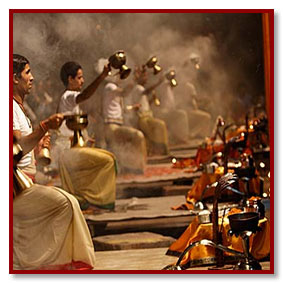
Day 11: Arrival / Varanasi
Meeting and assistance upon arrival and transfer to your hotel.
(Though Check – in time is 12 Noon, every effort would be made to ensure an as early as possible check-in)
Varanasi is quite possibly the world’s oldest living city. Religious artifacts link it to the sixth century B.C. Said to be founded by Shiva, Varanasi’s Vedic affiliation goes back to the beginning of time. It is also a city of many names. The present name, Varanasi (derived from the names of two nearby rivers) is mentioned in the Mahabharata. The ancient name is Kashi, the City of Light. To the devout it is also called Kashika, the shining one, referring to the light of Shiva. Many others prefer the anglicized Benares. Revered by Hindus, Buddhists and Jain alike, Varanasi is considered the holiest city in all of India. It is presided over by Shiva in his manifestation as Vishwanatha, Lord of the Universe. Buddha delivered a sermon in nearby Sarnath and Mahavira, the founder of Jainism, lived in Varanasi. As a result, more Indians will make a pilgrimage to Varanasi in their lifetime than any other place.
After wash & change we will proceed on a guided tour of several temples and the Hindu University at Benares. First stop would be the Bharat Mata (temple of Mother India). Inaugurated by Mahatma Gandhi, it features a huge marble map of India on the ground floor. Next up, the Durga Temple. Known for its bright red color and the playful, if sometimes aggressive, monkeys that run amok there, the Durga Temple is one of the most imposing architectural monuments in Varanasi.
The university, which occupies a large piece of land at the southern end of town, is also home to the New Vishwanatha Temple. The New Temple is modern in design and open to Hindus and non-Hindus alike. Surrounded by palm trees, it is a splendid white marble structure that shines in the afternoon sun against a pale blue sky. Inside, the temple is spacious and airy. The interior walls are covered with Vedic art above inscriptions from the Bhagavad Gita and Upanishads. In the center of the first floor is the Shiva linga.
Evening, we visit the ghats of Varanasi to witness the performance of Ganges Aarti. We enjoy a special evening cruise on the Ganges. See the Hindu devotees performing the "Puja" with lighted lamps. The view is very mesmerizing and the ambience is spectacular in the backdrop of the beating of cymbals and bells as well as the incessant chanting.
Overnight at hotel / guest house.
Day 12: Varanasi
At dawn we visit the sacred Ganges for a boat ride. Every morning at dawn hundreds of worshippers can be seen bathing in the sacred waters. The great river banks are lined with an endless chain of stone steps - the ghats - that stretch from one end of the city to the other. The Ghats form an impressive part of the religious landscape of the city. Proceeding downstream at a leisurely pace, you would be pointed out the significant temples and buildings as well as the changing architectural style. Life and death go hand in hand in Varanasi. While young people seek prosperity and protection from harmful influences, the older generation comes to Varanasi to cleanse their souls in the forgiving waters in preparation for their ultimate dissolution. Believing that anyone who dies in the river of life in Varanasi gains freedom from the cycle of birth and death, the City of Light has become a haven for the sick and aged waiting out their final days. The smoke that billows from the crematoriums on the edge of the river gives testimony to their final release from life’s earthly confines. We would dock our boat at Manikarnika (Cremation) Ghat. On any given day, anywhere from a few dozen to a few hundred corpses are cremated here; the ghat is assiduous with activity as the cremated bodies threw up smoke and fire.
Following the boat ride we set off on foot to explore the inner city. Through a twisted maze of narrow alleys, home to numerous shrines and pilgrim shops, we walk back a few centuries. Life here has stood still for years. The homes, the shops and even the cattle have not changed over the centuries. It is a brilliant nostalgic experience of timelessness.
This evening we take a short trip to the Buddhist city of Sarnath .It is here that the Buddha preached his first sermons after attaining enlightenment. The highlight of this tour would be a participation in the evening prayer service (aarti) of the main Buddhist temple here - the synchronized chanting of hymns to the accompaniment of traditional temple music is a sole stirring experience.
Overnight at Guest House .
Day 13: Varanasi / Kathmandu
Morning we will visit the bustling Gadolia bazaar where we only have to walk. You would never have seen so many cycle rickshaws and heard the cacophony of so many cycle rickshaw bells! It is an amazing spectacle of colour and lifestyles as you need to watch out for the pavement shops – especially the pavement dentist with a laughing set of dentures!!
Later transfer to the airport to board your flight to Kathmandu
Meeting and assistance upon arrival and transfer to your hotel Himalaya
Rest of the day is at leisure for your independent activities
Overnight at Hotel.
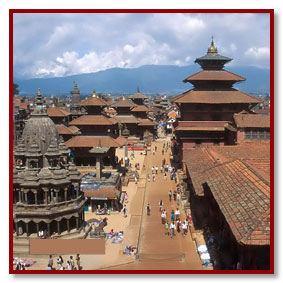
Day 14: Kathmandu
Morning we will procced on the Sightseeing of Kathmandu city visiting old Durbar Square with its medley of temple and shrines. We start our sightseeing form local Ason Bazaar where one can see city hubbubs of typical city life then proceed to Durbar Square where many monuments of historic interest such as the old palace – the historic seat of present royalty, Jagannath temple with erotic figures carved on its strut, Big Bell, Big Drum, Kaal Bhairav – the god of destruction, Kumari Ghar – the temple of only living goddess Kumari and Kasthamandap – The wooden rest those believed to be built from the wood of a single tree. After Kathmandu city sightseeing we will proceed to 2000 years old glorious Buddhist Stupa Swyambhunath Stupa, which sits atop a hillock overlooking Kathmandu valley.
Afternoon we will tour of Patan city and Tibetan Resettlement Camp. Patan or Lalitpur (literally meaning city of fine arts) is full of ancient palaces, temples and shrines, noted for their exquisite carvings. In the course of our sightseeing you will visit Patan Durbar Square, Krishna Mandir – 17th century stone temple with 21 spires dedicated to Lord Krishna, Mahabouddha – Buddhist temple made of clay bricks in which thousands of images of Lord Buddha are engraved, Hiranya Varna Mahavihar – a 12th century Buddhist temple which is also known as Golden Temple. Our tour will conclude with a visit to Tibetan Resettlement Camp where you can see Tibetan women weaving carpet in their looms.
Overnight at Hotel.
Day 15: Kathmandu
Today we proceed on a tour of sightseeing of Bodhnath Stupa and Pashupati Nath Temple and Bhaktapur Durbar squire.
Colossal Bouddhanath Stupa together with its octagonal base is one of the biggest Buddhist Chaityas in world. Painted on four sides of the spire base are all seeing eyes of Buddha. The surrounding area is made lively by the hustle bustle of Tibetan community rehabilitated here. For this reason the area is also known as little Tibet. Pashupatinath Temple, one of the most sacred temple in the Hindu World, is situated by the river Bagmati. The pagoda styled temple with its golden roof and silver walls is one of the finest temple. Devotees can be seen in the temple courtyard paying their homage to the god. Bhaktapur Durbar Square : The Golden Gate is the entrance to the main courtyard of the Palace of 55 Windows. Built by King Ranjit Malla, the gate is one of the most beautiful and richly carved specimens of its kind in the entire world. This gate is embellished with deities and monsters with marvelous intricacy. The Palace of 55 Windows was built in the 17th century. Among the brick walls in their gracious setting and sculptural design, is a balcony of 55 Windows. This balcony is a masterpiece of woodcarving. The stone temple of Batsala Devi, which is also located in the Durbar Square, is full of intricate carvings. This temple also sets beautiful example of Shikhara style architecture in Nepal. There is a bronze bell on the terrace of the temple, which is also known as the “ Bell of Barking Dogs”. This colossal bell, placed in 1737 AD, was rung to signal curfew during those days.
The main square of the city contains innumerable temples and other architectural showpieces like the Lion Gate, the Statue of King Bhupatindra Malla, the Picture Gallery, the Batsala temple, etc. A magnificent statue of King Bhupatindra Malla in the act of worship is placed in the column facing the palace of the many.
Overnight at Hotel.
Day 16: Kathmandu / Delhi
After a leisurely breakfast, transfer to the airport to board your flight to Delhi
Meeting and assistance upon arrival and transfer to hotel The Qutab
Rest of the day is at leisure for your independent activities
Overnight at delhi hotel.
Day 17: Delhi / Chennai
This morning, we visit Dilli Haat, a project conceived with the basic idea of providing encouragement and exposure to needy artisans and craftsmen all over the country who often spend their lives within the confines of their own village and town. The success of the project lied in freeing the craftsman and the artisan from the stranglehold of the middlemen and bringing them into direct contact with buyers both within the country and outside. Dilli Haat offers the visitor not only the arts and handicrafts of the country at one place, but also the cuisine and performing arts from different parts of the country. While developing the concept, it was kept in mind that when a ‘Haat’ comes to the city, it has to adjust to urban contemporary needs while retaining the cultural ambience familiar to rural crafts people.
Later transfer to the airport to board your flight to Chennai
Meeting and assistance upon arrival and transfer to hotel.
Overnight at delhi hotel.
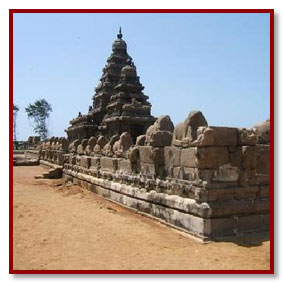
Day 18: Chennai / Mahabalipuram
After a leisurely breakfast we will proceed to the tour of one of India’s largest cities- Madras is the capital of the southern state of Tamil Nadu. The Tamillians are the proud inheritors of a rich cultural heritage, which is one of the main reasons for their beliefs of superiority over the hybridized culture of North India. Fort St. George (1653), built by the British, presently houses the State secretariat and the legislative assembly. The Fort has an interesting museum with fascinating collections of memorabilia from the early days of the British Raj. St. Mary’s Church (1678-80), was the first English church and the oldest surviving in India. The High court building, built of red sandstone has an interesting archaeological section and a bronze gallery. The former has an interesting collection of all major and ancient south Indian dynasties. The bronze section has interesting collections of Chola (9th century) bronze art. The High Court, built in Indo-Sracenic style is supposed to be the largest judicial building in the world after the Court Of England. The Kapaleshwar temple is an ancient Shiva temple in typical Dravidian (south Indian) style. Near the temple, the San Thome Cathedral (originally built in 1504), is a Roman Catholic Church believed to have the remains of St. Thomas the Apostle.
Later we will drive to Mahabalipuram
Upon arrival check into your hotel / Resort.
Overnight at hotel / Resort.
Day 19: Mahabalipuram / Kanchipuram / Mahabalipuram
Mahabalipuram is famous for its shore temples. The sculpture here is particularly interesting because, instead of Gods & Goddesses, the sculpture shows scenes from contemporary day to day life - women milking cows, pompous dignitaries, young girls priming and posing in street corners or swinging their hips in artful come-ons. Mahabalipuram is an easy going village of essentially two streets and positioned at the foot of low lying boulder strewn hill where most of the fascinating temples and the rock cut carvings are to be found. It affords a wonderful combination of an excellent beach, good seafood and the fascinating remains of an ancient Indian Kingdom
Later we will have an excursion of Kanchipuram.
Kanchipuram is a Hindu Holy City and capital of the Pallava dynasty from the 7th to 9th centuries AD, is renowned for temples and silk, and you will see plenty of both. The temples range in date from the 8th to the 17th century. The latest building was impressive in its size, the height of its gopuram, the intricacy of its carvings and wealth of colour, but, the earliest temples, of golden sandstone, are more aesthetically pleasing, the only colour provided is by a flock of ring-necked parakeets.
Across the road is a workshop where men sit at a loom, weaving fabrics that you will recognize immediately as "Madras cotton". However, Silk-weaving takes place on a grander scale than the cotton-weaving in this town dotted with cottage workshops. You could visit a factory where all the processes of spinning, dyeing and weaving take place. Of special note would be exquisite wedding saris made to order - the silk is heavily interwoven with gold thread. The sari and blouse are woven together so as to ensure a perfect match.
In the evening we will return to our hotel in Mahabalipuram
Overnight at hotel / Resort.
Day 20: Mahabalipuram / Pondicherry
After a leisurely breakfast we will drive to Pondicherry
Upon arrival check in to Hotel.
After rest and relaxation, we will proceed on a tour of the city. More than anything else, the Sri Aurobindo Ashram, where Sri Aurobindo and the Mother lived for the most parts of their lives, is a major attraction of this little city. The Pondicherry Museum is home to some of the most exquisite collections on architecture and sculpture. Pondicherry also has a pleasant beach alongside promenade and historical monuments. Some of the other interesting sites includes the Bharti and Bharthidasan Memorial museums and the Church of the Sacred Heart of Jesus.
The French, Britain's strongest rivals for the control of India, established their foothold here and only relinquished it in 1954. The town still has the feel of a French provincial town, with its librairie, epicerie, imposing Hotel de Ville, memorial to Franco-Indians killed in the Great War, and statue of Joan of Arc. The houses could be anywhere in southern France and bear the familiar white numbers on a blue ground. Street names, too, are shown in white on blue - rue St Louis, rue de la Caserne and so on. During a pleasant afternoon stroll you could hear French spoken frequently.
Overnight at Hotel.
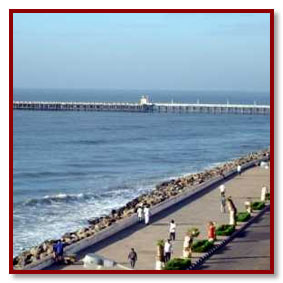
Day 21: Pondicherry / Tanjore / Trichy (245 Kms)
After breakfast we drive to Trichy Enroute we will visit Tanjore
Tanjore is also known as Thanjavur (The rice bowl of TAMIL NADU). We will proceed for sight seeing of Tanjore. Visit the famous Chola Temple of Brihadeeshwara - A WORLD HERITAGE MONUMENT. Its bronze and handicrafts make Tanjore one of the highlights of the tour to South India. The majesty of the palaces and art gallery attached to the temple is really awe-inspiring. It is also famous for the silk.
See the beautiful Chola temple of Brihadeeshwara. The temple is capped by a monolithic cupola made of a single granite block weighing 80 tons which was taken to the top with the help of a 6 km long ramp- an old technique used by the Egyptians for building pyramids. You will also visit the Palace and its Art Gallery, which contains several granite and bronze statues of the Chola period.
From here we will continue our drive to Trichy
Upon arrival check in to hotel.
Overnight at Hotel.
Day 22: Trichy / Madurai
Today’s program will add a new dimension to your India experience, as you sightsee in Trichy with an ascent to the Rock Fort, then follow the sacred Cauvery River to the Ramakrishna Tapovanam Ashram, or residential school, where a monk will lead you on a tour. Built of pure Hindu Ramakrishna Mutt style, the serene setting includes grasslands and coconut groves, a hostel and farm where devotees carry out educational and social activities. Continue to the Musiri where a scholar explains the Vedas so integral to Hindu life, with their themes of creation, preservation and destruction.
Later we will drive to Madurai
Upon arrival check in to the Hotel.
Overnight at Hotel.
Day 23: Madurai / Periyar
After breakfast we will proceed to the Guided tour of Madurai which is one of the oldest cities of southern India. It has been a center of pilgrimage, for centuries. The Meenakshi temple, the main architectural attraction here, is an excellent example of Dravidian architecture, with gopurams or multi pillared halls, covered from top to bottom, in a profusion of multicolored images of gods, goddesses, animals and mythical figures.
However, besides the temple, our tour includes a walk along the main street leading to the temple. The well-organized confusion caused by pilgrims in traditional clothes, pavement shops of all shades, holy men in robes of different colours etc add an unmistakable colour and atmosphere to this fascinating Temple City.
Later we will drive to the Periyar through the scenically vibrant valley of the Cardamom Hills of the Western Ghats. The Periyar Wildlife Sanctuary at Thekkady in Kerala, is one of the 16 Project Tiger Reserves in India. About a century ago, a British engineer, Col. J. Penn ycuick, chalked out a plan to dam the Periyar River, subsequently, a dam was constructed in 1895. This resulted in the adjoining forests being granted protection, by the Maharaja of Travancore. The 55 sq km reservoir and the surrounding forests, provide protection to the animals within. Today, Periyar is undeniably, one of the most impressive wildlife sanctuaries in the world.
Upon arrival check in to hotel / resort.
This evening, we will enjoy a boat ride along the lake into the more inner areas of the reserve. There is probably no sanctuary in the world where elephant behavior can be watched in such absolute comfort and safety. The total population is about 800. From the lake we can get as close as 20 meters to watch placid groups feeding, bathing and mud slinging. We end this adventurous day at our hotel, turning in for the night matching the tranquil pace of the forest around us.
Overnight at hotel / resort.
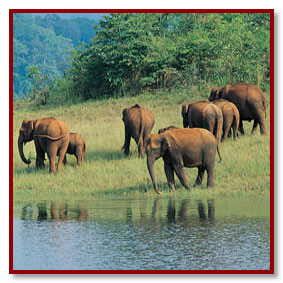 Day 24: Periyar
Day 24: Periyar
Following breakfast this morning we would take a short trek inside the forest. The birdlife comprises of darters, cormorants, kingfishers, great hornbills (the great Malabar hornbill) and racket-tailed drongoes. The reptilian population boasts of monitor lizards that can be spotted basking in the sun, on the rocks along the lakeshore, especially in the cooler months. Pythons, king cobras, flying lizards, flying squirrels, flying snakes and to top it all, flying frogs are the other inhabitants of this amazing sanctuary.
There are a few fascinating tribal villages around the Periyar, primarily the Manan and Oorali tribes. The Mana ns are ace fishermen, and a few of them still indulge in the traditional, if dangerous, practice of collecting the honey of large and deadly hill bees. The Ooralis build tree dwellings, though not as residences, but watchtowers to keep wild pigs, and elephants from ruining their crops.
After the trek, we board rafts made of bamboos for a rafting experience through some of the richest forest tracts of Periyar Tiger Reserve. The rafting is for about three hours and one gets a panoramic view of forest-clad hills reflected on the lake. Animals like elephant, gaur and sambar are sighted keeping close to the edges of the lake.
The team hitchhikes back to the boat landing by about 5 pm. An armed guard and guides will accompany us. Tea, snacks and packed lunch will be served Enroute
Overnight at hotel /resort.
Day 25: Periyar / Alleppey / Houseboat
After a leisurely breakfast we ride to Alleppey for a houseboat experience through the narrow canals and channels of the backwaters of Kerala.
The materials that go into the making of houseboat are all local and Eco-friendly; bamboo poles, coconut fiber ropes, bamboo mats carpets etc. The main wood used is "Anjali ". The Houseboat provides all comforts - Beds, a kitchen, western toilets and an upper deck. Traditional lanterns are used as lights. The cuisine is of traditional Kerala flavour along with the local Specialities - delicious fish and prawns.
Overnight abroad Houseboat
Day 26: Houseboat / Kumarakom
We spend the day Cruising on our boat through remote tribal villages along the tranquil backwaters of Kerala is a superb experience. Sensational in its own silent way, the cruise takes you along snake boat docks, friendly cheering villagers, coir (Jute) making communities, toddy (local spirit) shops, fishing nets pitched for the day's catch, bunded paddy fields and manual canoes of different sizes criss-crossing each other. The experience enables you to reach beautiful untouched areas.
Overnight at hotel.
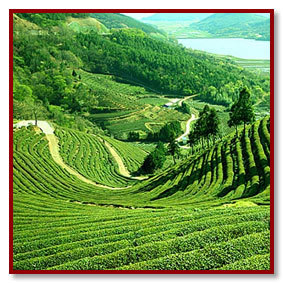
Day 27: Kumarakom
Day is free for independent activities. You can also enjoy the optional ayurvedic body massage at the resort. You could also choose to explore the surrounding tribal villages, visit the nearby water bird sanctuary or ride through the narrow backwater channels through back of beyond Kerala.
Overnight at Coconut Lagoon (Mansion Room)
Day 28: Kumarakom / Cochin
After a leisurely breakfast we will drive to Cochin
Upon arrival check in to hotel Trident
After rest & relaxation, we proceed on a guided tour of the City. The true character of the city is to be found in the older parts of the Fort Cochin area. It more or less exists as it used to be a 1000 years back, when it was first built. The roads have not been widened because the old haggard buildings, through patchwork repairs over the centuries, still stand on the edges. This part of the city reflects an unusual blend of medieval Portugal, Dutch and English country life grafted on to the tropical Malabar Coast. The fishing community of Cochin is also very interesting. They ancient cantilevered fishing nets called Chinese Fishing Nets. The net is fixed to a pole on the shore. While fishing, the entire net is lowered by a primitive fulcrum mechanism using long bamboo poles. By the same mechanism the pole is lifted along with the catch. We will explore the sights of Photographic as well as cultural interest. We would also visit the 16th century Mattancherry Palace, also known as the Dutch Palace since the Dutch substantially renovated the palace in the 17th century. The double storied quadrangular building surrounds a courtyard containing a Hindu temple. The Central Hall on the first floor was the coronation hall of the Rajas of Cochin; on display are their dresses, turbans and palanquins. The most important feature of this palace, however, is the astonishing murals in the bedchambers and other rooms, which depict scenes from the Ramayana and other religious legends. These murals are undoubtedly some of the most beautiful and extensive anywhere to be seen in India. The unique feature here is the unexpected and isolated Jewish community, whose origins date back to AD 52. They are self-contained and have there own Synagogue.
The area around the Synagogue, known, as ‘Jew Town’ is one of the main centres of spice trade. Scores of small firms huddle together in old dilapidated buildings and the air is filled with the aroma of ginger, cardamom, cumin, turmeric and cloves. The area is very busy. The potters are loading gunny bags of spices on to carts, which keep running up and down the narrow lanes. We would visit Jew Town, in the Mattancherry section and a short walk from the ferry, is one street long. Jews used to occupy virtually all the houses on Jew Town Road, where they sold fruits, vegetables and spices or worked as oil pressers or carpenters. The spice markets are still located on the narrow street.
Kathakali Dance :
A special treat awaits us this evening as we proceed to witness the strength and vigor of Kathakali dance drama, as it enacts episodes from great Indian epics. The extremely stylized gestures, the elaborate make-up, the masks and the splendid costumes of these all-male dancers, recreates an incomparable sense of pageantry.
Overnight at hotel.
Day 29: Cochin / Departure
Transfer to the airport to board your flight back home
